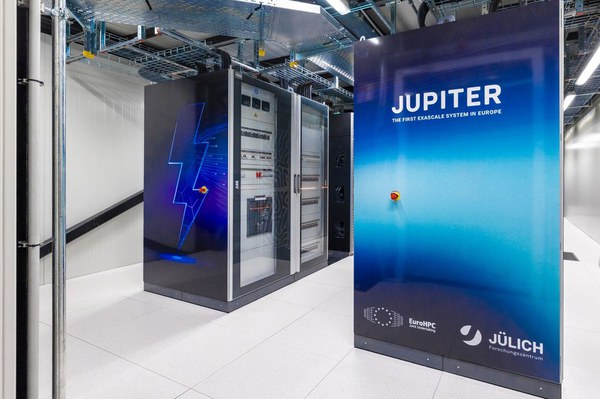ICON Simulation Nominated for Gordon Bell Prize for Climate Modelling
JSC researchers contribute to the performance optimisation of a newly developed configuration of the ICON climate model, which will allow for the simulation of decadal-scale climate change at unprecedented resolution on JUPITER and other large-scale supercomputers. In recognition of this accomplishment, the project has been selected as one of the three finalists for the Gordon Bell Prize for Climate Modelling. The American Association for Computing Machinery awards the prize in this new category since 2023 to recognise innovations that advance the understanding of the climate system and climate change. The award will be presented in November during the SC25 conference, the world’s most important HPC meeting.
In April, the researchers used 8000 NVIDIA Grace-Hopper (GH) superchips on the Alps supercomputer at the Swiss National Supercomputing Centre (CSCS), to produce high-resolution ICON simulations of the Earth system. This ICON configuration is currently being prepared for the first European Exascale supercomputer JUPITER at JSC and will be one of the first applications on Europe’s largest supercomputer. Each of JUPITER’s about 6000 booster nodes features four Grace-Hopper superchips, i.e. about 24 000 GH superchips in total, allowing for even larger and more detailed ICON simulations.

Until recently, simulations of the entire Earth system, including the energy, water, and carbon cycles, at a resolution of one kilometer and over several decades were considered impossible. The number of relevant processes was deemed too large, their interactions too complex, the time scales too long, and the necessary computing power too high. A team from many institutions and led by the Max Planck Institute for Meteorology (MPI-M) developed a configuration of the ICON model capable of handling this task. By running this setup on the newest supercomputers, the team demonstrated that simulations of the Earth system with a resolution of 1.25 kilometers can indeed be performed, even including the full carbon cycle, and with a throughput that enables studying multi-decadal climate change.
Within the JUPITER Research and Early Access Program (JUREAP), JSC contributes its expertise in performance optimization and system co-design to prepare ICON for deployment on JUPITER. Working closely with MPI-M, DKRZ, CSCS, ETH, and NVIDIA, JSC researchers help to adapt ICON to heterogeneous GPU-based architectures to achieve both high throughput and energy efficiency. While ICON has long been a key application on JSC’s supercomputers, JUPITER will for the first time make it possible to scale the model across tens of thousands of GPUs. This breakthrough will establish JUPITER as a central platform for climate research in Europe, enabling kilometer-scale simulations over decades and providing a crucial foundation for more accurate and reliable climate projections.
The efficiency of the ICON model on current and upcoming HPC systems makes it possible to run fully coupled global climate simulations for different future scenarios. These simulations provide important information for planning local climate adaptation strategies, a process that will be significantly advanced with Europe entering the Exascale supercomputing era.
Contact: Dr. Lars Hoffmann, Dr. Andreas Herten
